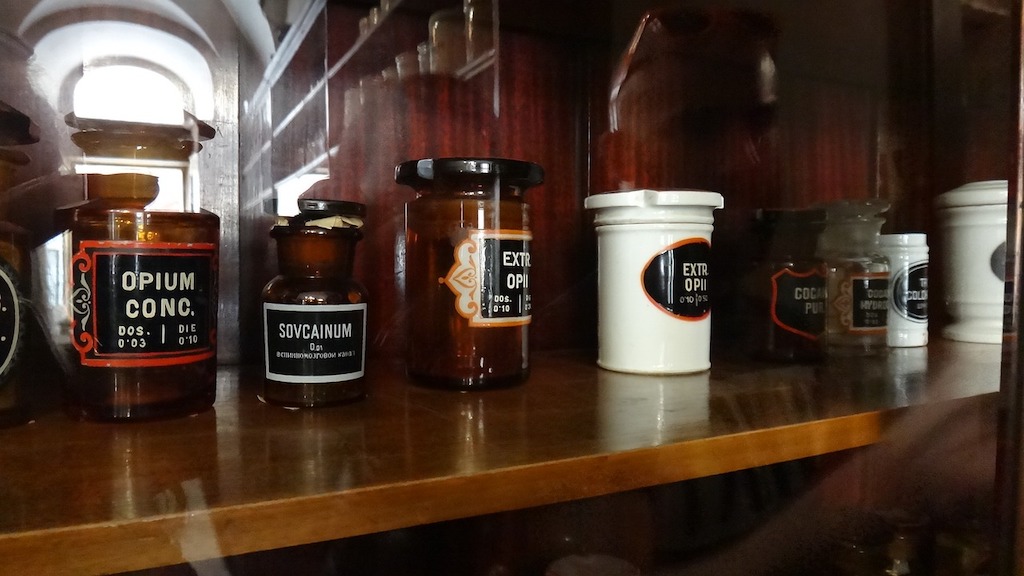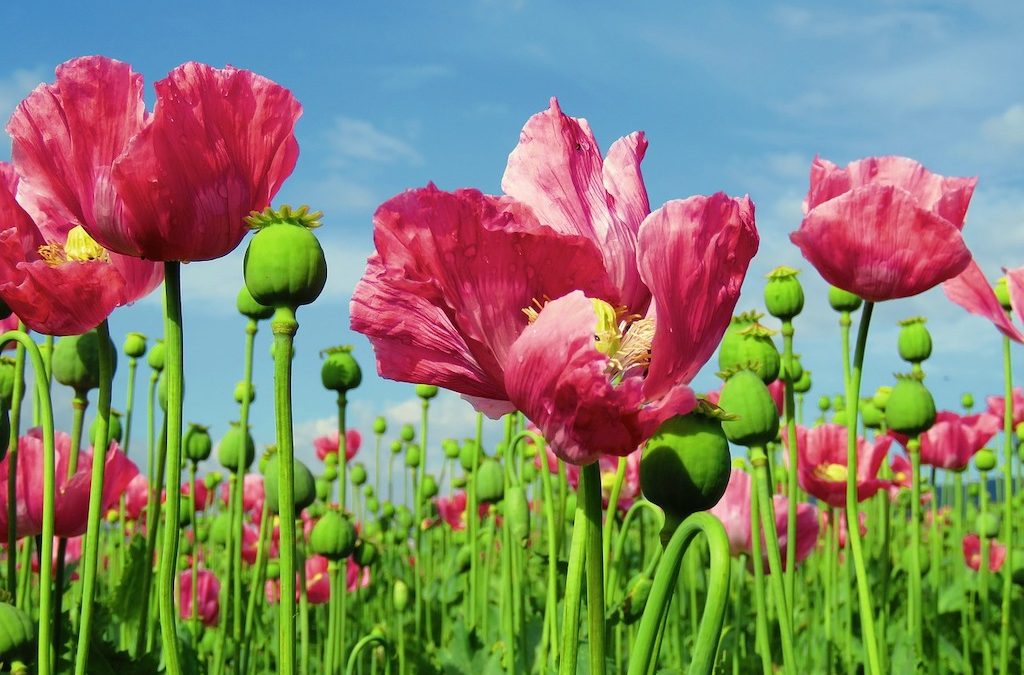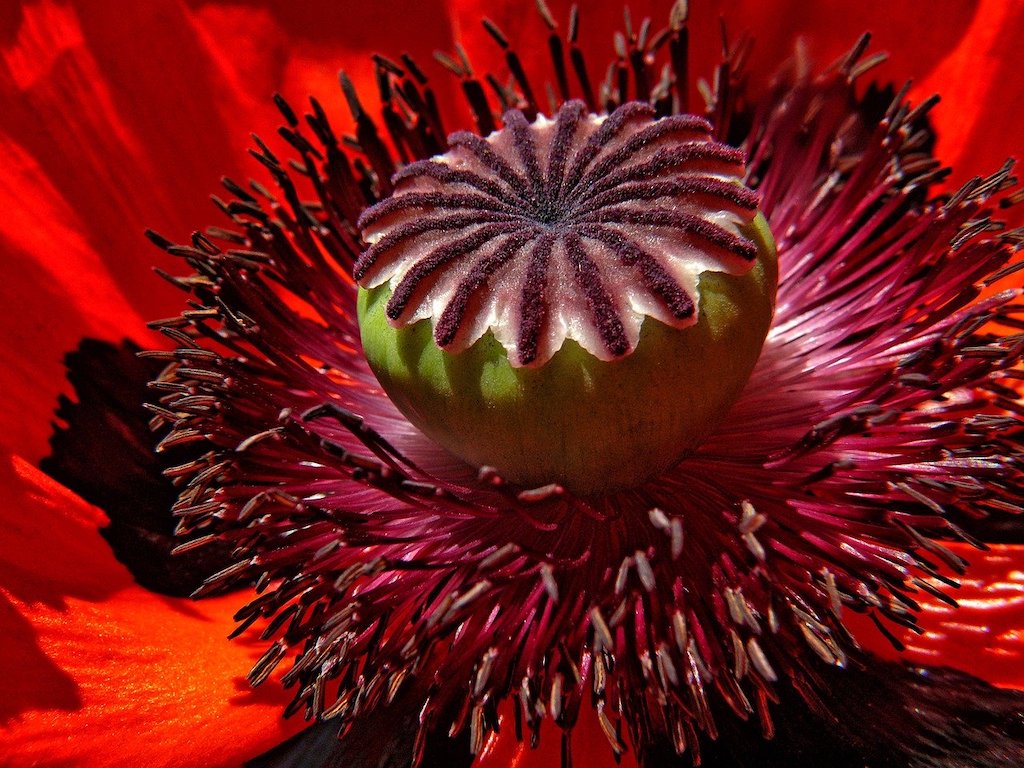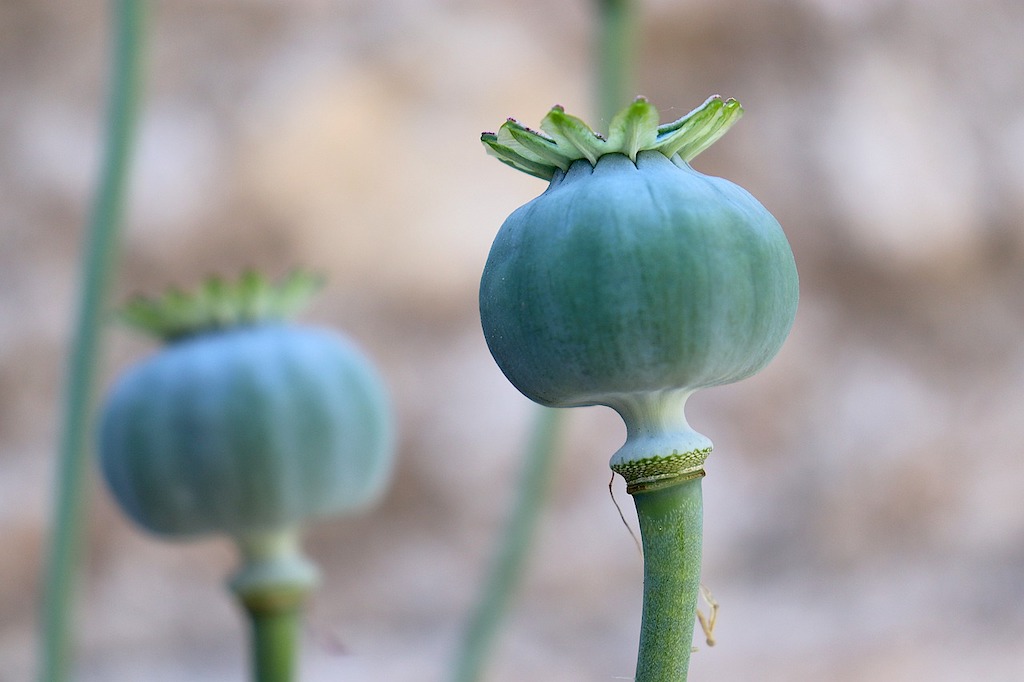Plant Profile: Poppy (Papaver somniferum)
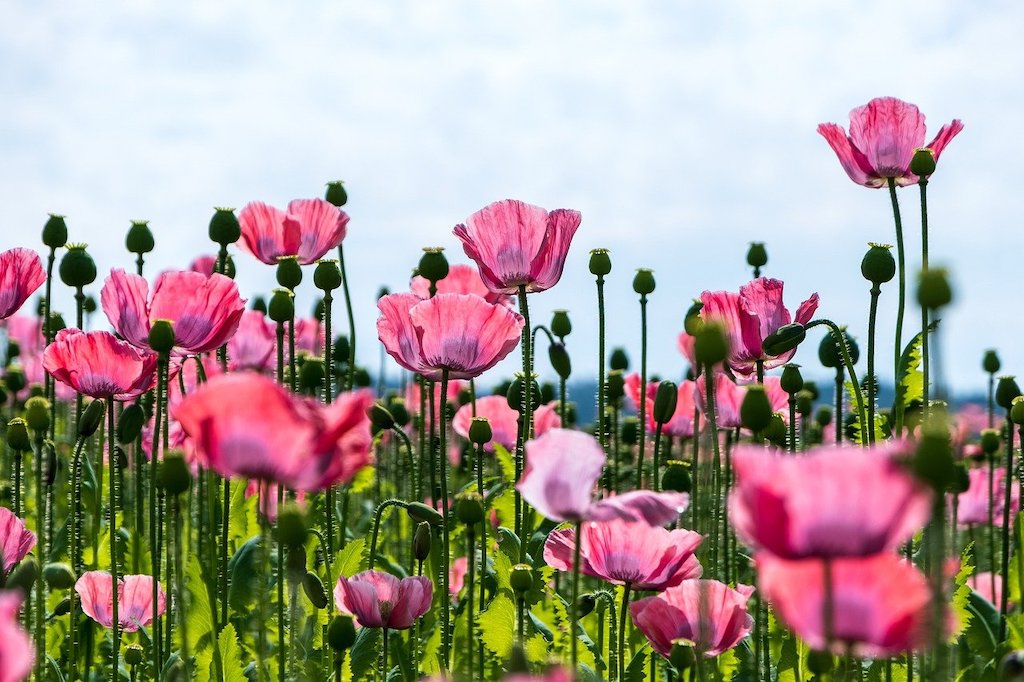
The Mysterious History of the Opium Poppy
| Opium Poppy | Papaver somniferum |
| Synonyms | Opium Poppy, Mawseed, Herb of Joy, Mohn, Klapper-Rosen, Mago, Magesamen, Weismagen, wilder Magen, Magensaph, Rosule |
Description:
Opium Poppies are nothing if not showy. Their sturdy stems and large leaves make a stark contrast to their large but oddly flimsy flowers. The delicate petals give the impression of a butterfly that is just about to take off. At the base of the flower sits a prominent, many-rayed stigma surrounded by a mass of stamens. After the flower has been fertilized, the petals drop off, leaving the seed capsule exposed as it swells and ripens like a pregnant belly.
Individual plants grow to between 70 cm, and 130 cm tall. The erect stems and large wavy leaves have a tough, rubbery texture. The leaves are indented and clasp the stem. All green parts of the plant are covered by a greyish-blue waxy substance that is easily rubbed off. Botanists describe this feature as glaucous.
When any green part is cut or wounded, a milky latex oozes out and turns brown as it dries. This substance is known as raw opium.
The seed capsule of Papaver somniferum is almost spherical and has a star-shaped, flattened lid. As it dries, the top shrinks and lifts. Tiny holes are formed underneath the rim, allowing the tiny, white or bluish-black seeds can disperse.
Origin and Distribution
It is difficult to establish with any certainty just where Papaver somniferum originated or who its genetic parents might have been. But, most researchers now agree that the Mediterranean region of Asia Minor is its most likely ‘original home’.
From this strategically advantageous position, they spread east into Asia, south into North Africa and north into Central Europe. Today, poppies are even found as far north as Britain. Poppies are popular as ornamentals, and breeders have developed dozens of varieties of different colours and flower arrangements.
The Papaver genus comprises about 100 species that occur throughout the temperate regions of the world. Poppies like to grow in association with corn. In early summer, the related Scarlet Poppy (Papaver rhoeas) can often be seen in cornfields and verges. This species is much smaller, has scarlet-red petals and small, elongated seed capsules. Although the Scarlet Poppy has historically also been used medicinally, its action is much milder than that of Papaver somniferum.
Opium Poppies are not native to the New World. But when they appeared on their shores, Eastern tribes adopted their medicinal uses, which they learned from the Europeans.
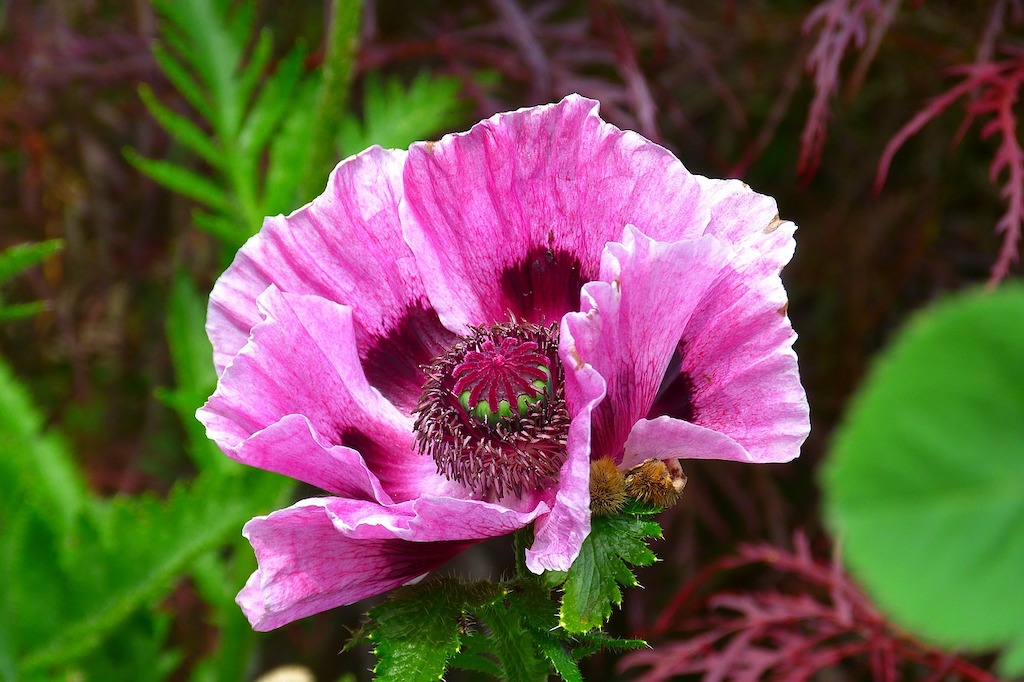
The delicate Poppy flowers are beautiful to behold. Their papery petals gently waft in the summer's breeze - alas, it is a short-lived beauty. Here one day, gone the next. The fleeting splendour only lasts a few days before the petals fall, revealing a bulging seed pod.
The seed pods hold a myriad of tiny poppy seeds, a familiar item of the kitchen larder. We use them as toppings of bread rolls and bagels, or as cake fillings. Less commonly available is the delicately nutty seed oil, highly esteemed in gourmet cuisines.
But poppy has a secret power, and it flows within its fleshy stems, leaves and unripe seed capsules: its milky latex.
When it oxidizes and dries, the latex turns brown and becomes what the Ancients knew as 'opion'. This substance has been used for thousands of years. In the days of blood and gore, opion was a god-sent pain-reliever. Even today, the most effective pain relievers are still predominantly based on it.
Thanks to its potent analgesic and hypnotic properties, Opium relieves not only physical but also emotional pain. But woe to those who are seduced by it. Taken too regularly, it entraps the body and chains the mind to addiction, causing delusion, apathy, and even death.
Yet, in the words of Paracelsus:
"What is there that is not poison? All things are poison, and nothing is without poison. Solely the dose determines that a thing is not a poison.”
Our age-old relationship with poppies proves the point. Throughout history, it has brought great relief but also suffering and death.
Historical record
Archaeological evidence suggests that humans have used poppies since pre-historic times. Archaeobotanists have found charred remains of poppies and opium at Neolithic settlements, burial sites and even in the tombs of Egyptian Pharaohs. The latter were even decorated with paintings of Opium Poppy, Mandrake and Blue Water Lily - all considered magical plants connected to the underworld gods.
The earliest written record was found in Sumer and dates back to about 2000 B.C. It refers to poppies as 'Hul Gil' - the Herb of Joy. From Sumer, the knowledge and use of poppies spread throughout the Middle East to Babylonia, Assyria and Egypt, Persia and Greece.
They are mentioned in the famous Egyptian Eber's Papyrus (1500 B.C.), which recommends them as a remedy to calm incessantly crying babies. Remarkably, this use has persisted until the beginning of the 20th century in parts of North Africa and Europe. It certainly kept children quiet, but it also reduced their natural curiosity, thus dimming their wits.
From Hippocrates to Avicenna, Dioscorides and Galen - all the ancient medical texts mention opium as an effective painkiller and sedative.
Dioscorides offers a detailed description of how to obtain the latex:
"Those who wish to obtain the sap (of the Poppy) must go after the dew has dried, and draw their knife around the star in such a manner as not to penetrate the inside of the capsule, and also make straight incisions down the sides. Then with your finger wipe the extruding tear into a shell. When you return to it not long after, you will find the sap thickened, and the next day you will find it much the same. Pound the sap in your mortar and roll the mass into pills."
[/et_pb_text]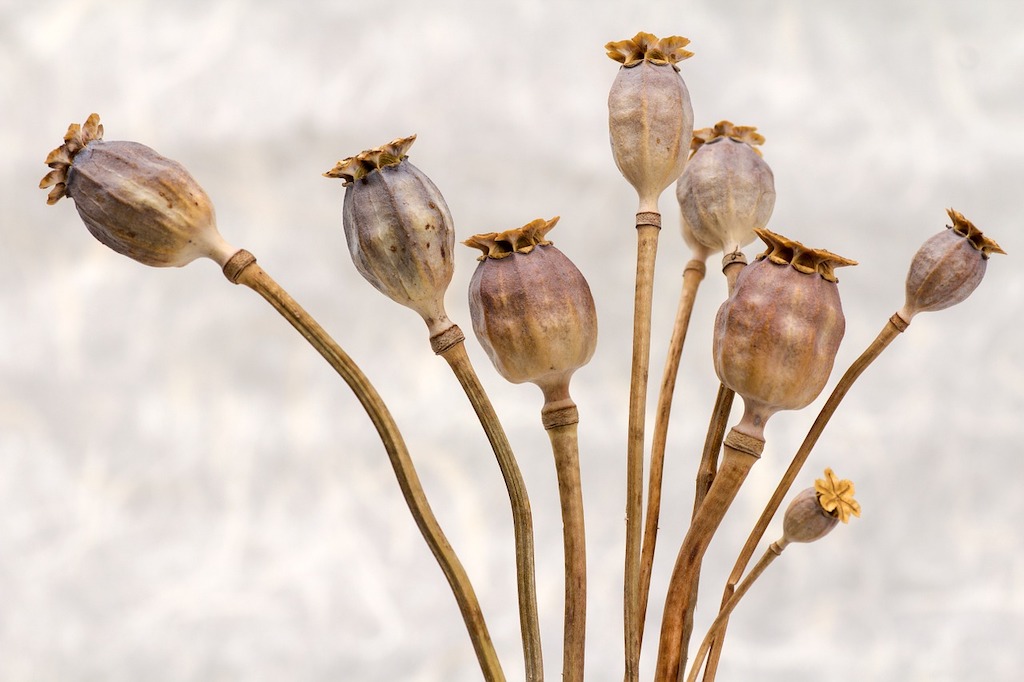
Poppies were considered sacred to Hypnos, the Greek god of sleep, and they guarded the entrance to his drowsy realm. Hypnos is often depicted holding the seed capsules in his hands and adorning his head. He brought prophetic dreams and soothed emotional pain with forgetfulness.
At the temple of Aesclepius on the Greek island of Cos, poppies were used in a kind of sleep therapy. Aesclepius is a god of healing, but the only medicine he prescribed was a potent brew of opium and other herbs, while the therapeutic recommendations were revealed directly to the patients via visionary dreams.
The Romans identified Hypnos with their god of sleep, 'Somnus', who lent his name to poppies scientific nomenclature. 'Somniferus' comes from the Latin 'somnus ferre', - bringer of sleep.
Poppies had a strong association with the gods of the Underworld. In Greek mythology, they were sacred to Thanatos or Hades, the Lord of the Underworld, and ruler of the realm of the dead. Excessive doses of opium can bring eternal sleep.
But they were also sacred to Demeter, the Earth-Goddess, who taught humankind the art of agriculture and particularly the cultivation of grains such as wheat and barley. Demeter was, of course, inconsolable when Hades abducted her daughter Persephone. Only poppies managed to soothe her pain. Poppies love mingling among the cornfields, and their bulging seed pods, containing an abundance of tiny seeds, serve as a perfect symbol of fertility.
Some scholars believe that opium was a chief ingredient of the secret ritual drink served at the Elysian Mystery rites. Unfortunately, the recipe ranks among the best-kept secrets of the ancient world, so we will never know for sure.
Mythology tells us that poppies sprang from Aphrodite's tears as she mourned the loss of her lover, Adonis. In ancient times, her birthplace, the island of Cyprus, was a major centre of poppy cultivation and trade.
[/et_pb_text]Folk Magic
Poppy's association with the goddess of love is also reflected in its relaxing aphrodisiac properties. Opium was very popular in folkloristic love magic. During the Middle Ages, it was the ingredient of choice for love charms, philtres and potions. Poppies were also tasked with predicting the fortunes of lovers. To learn the identity of a future spouse or divine the outcome of a love affair, the inquirer would write his question on a piece of parchment and place it inside a poppy seed capsule. The seed pod was then placed under the pillow until a prophetic dream would reveal all.
Naturally, love associates with fertility. The belly-like seed pod full of seeds makes an apt symbol not just of fertility, but also of prosperity. On New Year's Eve, giving gifts of poppy sweetbread served as tokens of prosperity blessings, while the seed capsules were used as a fertility charm.
Invisibility was also considered one of the poppy's magic powers. For this purpose, it was included in a magic potion. This use is probably linked to the myth of Persephone. It is believed that Hades' wore a cap of invisibility that resembled a poppy seed pod when he abducted Persephone.
Yet, poppy seeds are also said to be anti-demonic. If one found such nasty creatures hard on one's heels, all one had to do to get rid of them was to toss some poppy seeds in their direction. Apparently, demons and vampires are compelled to count everything. A handful of scattered poppy seeds would keep them busy long enough to allow you to escape.
From traditional herbal medicine to potent pharmaceutical drug and addiction
Opium was widely used in the ancient world, but it was Andromachos, the personal physician of Emperor Nero, who popularized it. One day, Nero challenged Andromachos to create a true panacea, a remedy that would ease all pain and diseases. The physician came up with a potent potion consisting of about sixty different plants and substances, including opium, which he called 'Theriak'. Later, Galen refined the brew and renamed it Galene. It became so popular throughout Europe that it rose to the status of a miracle cure. But the potion was expensive, and some ingredients were difficult to obtain, which led to adulteration.
During the Middle Ages, medicine became 'heroic' - in other words, unsympathetic, and patients were expected to simply bear their pain. The use of opium as a painkiller declined. But eventually, Paracelsus revived it by creating a stripped-down version of the original Theriak recipe, which proved extremely effective and soon surpassed even the success of the original. He compounded his concoction into pill form and called it 'Laudanum Paracelsi'.
Laudanum
He had managed to make his painkiller even more effective by the simple addition of lemon juice. The acid subtly changes opium's chemistry and enhances its anodyne action. For a long time, Laudanum was a celebrated panacea, believed to be effective for every ailment except leprosy.
The somewhat hyperbolic reputation meant that it was often in short supply. But it also pricked scientific curiosity and inspired numerous experiments. It even gave rise to the groundbreaking invention of the hypodermic needle. In 1656, Sir Christopher Wren first employed a syringe to prove the theory of blood circulation. He injected a dog's hind leg with a solution of opium, and sure enough, the drug rapidly took effect over the dog's entire body.
In 1680, the English Doctor Thomas Sydenham revised Paracelsus' potion once again. His aim was to purify the raw drug and rid it of impurities that seemed to cause 'sickness' when taken in large quantities. He added sherry wine, saffron, cinnamon and cloves to Paracelsus' Laudanum and renamed it 'Sydenham's Laudanum'. It was no more effective than the original, but it kicked off a new wave of enthusiasm for opium-based products. Soon every chemist seemed to market their own blend. Venice Treacle, Mithridate, London Laudanum and Dr Bate's Pacific Pills all became popular household names. But the available raw opium could barely keep up with the demand.
Laudanum was as popular as aspirin is today. Physicians routinely prescribed twice-weekly preventative dosing. Alas, sometimes too much of a good thing proves, well..., too much.
Overprescription and Addiction
It was at this time that overprescription led to the first cases of serious opium addiction. The problem was compounded by the fact that Laudanum was even overprescribed for children. But the problem with an addictive substance such as opium is that frequent dosing increases the body's resistance, and larger amounts are required to get the same results.
In 1700, Dr John Jones published a book called 'The Mysteries of Opium Revealed'. In the course of about 400 pages, he extolled the properties of opium. Describing its uses and effects, he also reported on its pleasant side effects and symptoms of addiction. Although his work was clearly biased and likely to have been influenced by his own intimate relationship with the subject, it did contain a grain of genius. Jones was the first to intuit that opium actually imitated substances that are already present in the body. But it took another 275 years before scientists discovered these substances, which subsequently became known as endorphins.
Morphine
Debate and experimentation continued. In 1799, Friedrich Sertürner, a young German pharmacist's apprentice, observed that the effects of opium seemed to vary considerably from batch to batch. He became convinced that this must be due to the varying presence of an active constituent in the raw opium. After only four years of experimentation, he managed to isolate such a substance. In allusion to the Greek god of sleep, he called 'morphine'. But he wrongly believed that this purified compound was free of the unpleasant characteristics of opium. He had assumed that morphine was safer because only a tiny amount of it was necessary to induce far stronger effects than those of raw opium. But neither he nor anyone else at the time realized that it was also far more addictive. Soon, several pharmaceutical companies started to churn out morphine by the boatload. At the same time, Wren's earlier invention for injecting opium was perfected and morphed into what we now know as the hypodermic syringe. The improvement was celebrated as a great success, since the administration of morphine via a syringe tripled its efficacy.
The story of opium epitomizes the risk of relying on science to solve all our problems. Sometimes the solution to one problem engenders new ones that we only fully grasp much later.
(The history of poppy also has a very interesting, dark and thought-provoking political aspect, which, however, is beyond the scope of this article. Those interested in this plant and its impact on world history should read up on the opium wars - the consequences of which still linger.

